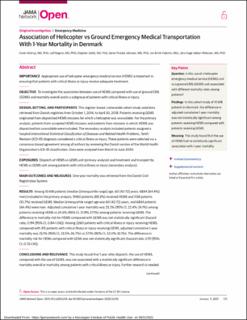| dc.contributor.author | Alstrup, Karen | |
| dc.contributor.author | Rognås, Leif Kåre | |
| dc.contributor.author | Sollid, Stephen J. M. | |
| dc.contributor.author | Johnsen, Søren Paaske | |
| dc.contributor.author | Valentin, Jan | |
| dc.contributor.author | Petersen, Jens Aage Kølsen | |
| dc.coverage.spatial | Denmark | en_US |
| dc.date.accessioned | 2021-10-18T11:47:39Z | |
| dc.date.available | 2021-10-18T11:47:39Z | |
| dc.date.created | 2021-09-20T10:14:54Z | |
| dc.date.issued | 2021-01 | |
| dc.identifier.citation | Alstrup, K., Rognås, L., Sollid, S. et al. (2021) Association of Helicopter vs Ground Emergency Medical Transportation With 1-Year Mortality in Denmark. JAMA Network Open, 4(1):e2033318 | en_US |
| dc.identifier.issn | 2574-3805 | |
| dc.identifier.uri | https://hdl.handle.net/11250/2823681 | |
| dc.description.abstract | Importance Appropriate use of helicopter emergency medical service (HEMS) is important in ensuring that patients with critical illness or injury receive adequate treatment.
Objective To investigate the association between use of HEMS compared with use of ground EMS (GEMS) and mortality overall and in a subgroup of patients with critical illness or injury.
Design, Setting, and Participants This register-based, nationwide cohort study used data retrieved from Danish registries from October 1, 2014, to April 30, 2018. Patients receiving GEMS originated from dispatched HEMS missions for which a helicopter was unavailable. For the primary analysis, patients from accepted HEMS missions and patients from missions in which HEMS was dispatched but unavailable were included. The secondary analysis included patients assigned a hospital International Statistical Classification of Diseases and Related Health Problems, Tenth Revision (ICD-10) diagnosis considered a critical illness or injury. These patients were selected via a consensus-based agreement among all authors by reviewing the Danish version of the World Health Organization’s ICD-10 classification. Data were analyzed from March to June 2020.
Exposures Dispatch of HEMS vs GEMS unit (primary analysis) and treatment and transport by HEMS vs GEMS unit among patients with critical illness or injury (secondary analysis).
Main Outcomes and Measures One-year mortality was retrieved from the Danish Civil Registration System.
Results Among 10 618 patients (median [interquartile range] age, 60 [42-72] years; 6834 [64.4%] men) included in the primary analysis, 9480 patients (89.3%) received HEMS and 1138 patients (10.7%) received GEMS. Median (interquartile range) age was 60 (42-72) years, and 6834 patients (64.4%) were men. Adjusted cumulative 1-year mortality was 23.2% (95% CI, 22.4%-24.1%) among patients receiving HEMS vs 24.5% (95% CI, 21.9%-27.1%) among patients receiving GEMS. The difference in mortality risk for HEMS compared with GEMS was not statistically significant (hazard ratio, 0.94 [95% CI, 0.84-1.06]). Among 2260 patients with critical illness or injury receiving HEMS, compared with 315 patients with critical illness or injury receiving GEMS, adjusted cumulative 1-year mortality was 25.1% (95% CI, 23.5%-26.7%) vs 27.1% (95% CI, 22.0%-32.1%). The difference in mortality risk for HEMs compared with GEMs was not statistically significant (hazard ratio, 0.91 [95% CI, 0.73-1.14]).
Conclusions and Relevance This study found that 1 year after dispatch, the use of HEMS, compared with the use of GEMS, was not associated with a statistically significant difference in mortality overall or mortality among patients with critical illness or injury. Further research is needed to determine whether optimized dispatch systems may be associated with further improvements in survival among selected patients. | en_US |
| dc.language.iso | eng | en_US |
| dc.publisher | Jama Network | en_US |
| dc.rights | Navngivelse 4.0 Internasjonal | * |
| dc.rights.uri | http://creativecommons.org/licenses/by/4.0/deed.no | * |
| dc.subject | akuttmedisin | en_US |
| dc.subject | luftambulanse | en_US |
| dc.subject | HEMS | en_US |
| dc.subject | ambulanse | en_US |
| dc.subject | Danmark | en_US |
| dc.title | Association of Helicopter vs Ground Emergency Medical Transportation With 1-Year Mortality in Denmark | en_US |
| dc.type | Peer reviewed | en_US |
| dc.type | Journal article | en_US |
| dc.description.version | publishedVersion | en_US |
| dc.rights.holder | © 2021 Alstrup K et al. | en_US |
| dc.subject.nsi | VDP::Medisinske Fag: 700::Klinisk medisinske fag: 750::Traumatologi: 783 | en_US |
| dc.source.volume | 4 | en_US |
| dc.source.journal | JAMA Network Open | en_US |
| dc.source.issue | 1 | en_US |
| dc.identifier.doi | 10.1001/jamanetworkopen.2020.33318 | |
| dc.identifier.cristin | 1935814 | |
| dc.relation.project | SHARE - Centre for Resilience in Healthcare: 5091 | en_US |
| dc.relation.project | Norges forskningsråd: 275367 | en_US |
| dc.source.articlenumber | e2033318 | en_US |
| cristin.ispublished | true | |
| cristin.fulltext | original | |
| cristin.qualitycode | 1 | |

